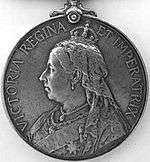China War Medal (1900)
| China War Medal 1900 | |
|---|---|
|
Obverse (top left) and reverse (top right) of the medal. | |
| Awarded by United Kingdom of Great Britain and Ireland | |
| Type | Campaign medal |
| Eligibility | British and Imperial forces. |
| Awarded for | Campaign service. |
| Campaign | Boxer Rebellion 1900. |
| Description | Silver disk, 36mm diameter. |
| Clasps |
|
| Statistics | |
| Established | 1901 |
 Colour version of medal and ribbon. | |
The China War Medal 1900 was a British campaign medal approved in 1901 for issue to British and Imperial land and sea troops who fought during the Boxer Rebellion of 1900. Issued in silver to combatants and in bronze to native, namely Indian, bearers drivers and servants, it could be issued without a clasp or with one or more of the following;
Clasps
- Taku Forts
Awarded to naval personnel of the British contingent of the international fleet involved in the attack of the Taku forts along the Peiho River
- Defence of Legations
Awarded to 80 Royal Marines and several 'odd' men of the British Legation Guard, who aided the defence of the Legation Quarter in Peking for 55 days.
- Relief of Peking
Awarded to British and Indian army personnel and to men of the Royal Navy involved in the relief of the Legations in Peking as part of the international relief force commanded by Count Alfred von Waldersee or as part of Vice-Admiral Edward Seymour's Naval Brigade (see Seymour Expedition).
The medal used the same reverse as the two previous China War medals, a trophy-of-arms, with the obverse consisting of the bust of Queen Victoria.
The medal was awarded to 555 naval personnel of the Colonial navies of Australia without a clasp: 256 men with the New South Wales Contingent, 197 with the Victorian, and 102 on the South Australian gunboat Protector.

